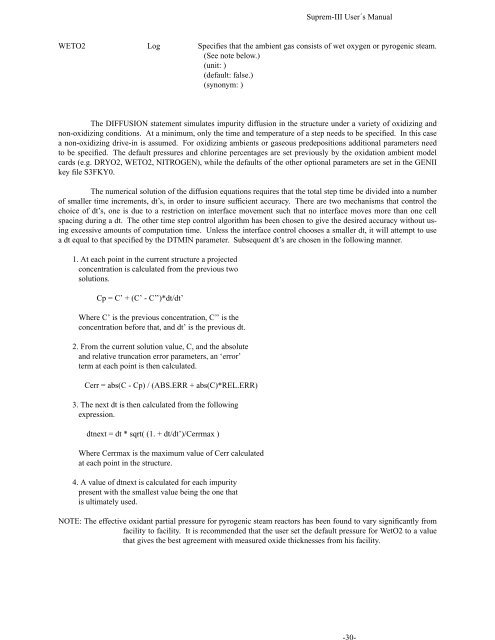Suprem III - Stanford Technology CAD Home Page
Suprem III - Stanford Technology CAD Home Page
Suprem III - Stanford Technology CAD Home Page
Create successful ePaper yourself
Turn your PDF publications into a flip-book with our unique Google optimized e-Paper software.
-30-<br />
<strong>Suprem</strong>-<strong>III</strong> User´s Manual<br />
WETO2 Log Specifies that the ambient gas consists of wet oxygen or pyrogenic steam.<br />
(See note below.)<br />
(unit: )<br />
(default: false.)<br />
(synonym: )<br />
The DIFFUSION statement simulates impurity diffusion in the structure under a variety of oxidizing and<br />
non-oxidizing conditions. At a minimum, only the time and temperature of a step needs to be specified. In this case<br />
a non-oxidizing drive-in is assumed. For oxidizing ambients or gaseous predepositions additional parameters need<br />
to be specified. The default pressures and chlorine percentages are set previously by the oxidation ambient model<br />
cards (e.g. DRYO2, WETO2, NITROGEN), while the defaults of the other optional parameters are set in the GENII<br />
key file S3FKY0.<br />
The numerical solution of the diffusion equations requires that the total step time be divided into a number<br />
of smaller time increments, dt’s, in order to insure sufficient accuracy. There are two mechanisms that control the<br />
choice of dt’s, one is due to a restriction on interface movement such that no interface moves more than one cell<br />
spacing during a dt. The other time step control algorithm has been chosen to give the desired accuracy without using<br />
excessive amounts of computation time. Unless the interface control chooses a smaller dt, it will attempt to use<br />
a dt equal to that specified by the DTMIN parameter. Subsequent dt’s are chosen in the following manner.<br />
1. At each point in the current structure a projected<br />
concentration is calculated from the previous two<br />
solutions.<br />
Cp = C’ + (C’ - C’’)*dt/dt’<br />
Where C’ is the previous concentration, C’’ is the<br />
concentration before that, and dt’ is the previous dt.<br />
2. From the current solution value, C, and the absolute<br />
and relative truncation error parameters, an ‘error’<br />
term at each point is then calculated.<br />
Cerr = abs(C - Cp) / (ABS.ERR + abs(C)*REL.ERR)<br />
3. The next dt is then calculated from the following<br />
expression.<br />
dtnext = dt * sqrt( (1. + dt/dt’)/Cerrmax )<br />
Where Cerrmax is the maximum value of Cerr calculated<br />
at each point in the structure.<br />
4. A value of dtnext is calculated for each impurity<br />
present with the smallest value being the one that<br />
is ultimately used.<br />
NOTE: The effective oxidant partial pressure for pyrogenic steam reactors has been found to vary significantly from<br />
facility to facility. It is recommended that the user set the default pressure for WetO2 to a value<br />
that gives the best agreement with measured oxide thicknesses from his facility.















